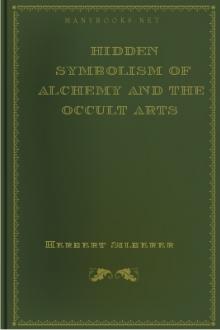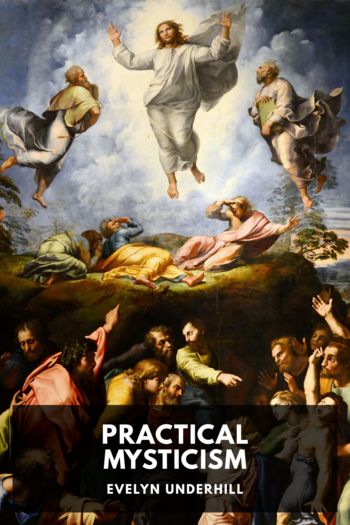Hidden Symbolism of Alchemy and the Occult Arts by Herbert Silberer (e book reader free .txt) 📕

- Author: Herbert Silberer
- Performer: -
Book online «Hidden Symbolism of Alchemy and the Occult Arts by Herbert Silberer (e book reader free .txt) 📕». Author Herbert Silberer
In view of the difficulty of the mystic work that attempts to accomplish a sheerly superhuman task, it is not surprising that it cannot be finished in one attempt but requires time. It necessitates great persistence. In the life of the mystic the states of love and aspiration for God alternate with those of spiritual helplessness and barrenness. (Horten, Myst., I, p. 9.)
Arabi sings in his ode on man's becoming godlike: “[1] O thou ancient temple. A light has arisen [pg 366] for thee (you) that gleams in our hearts. [2] To thee I lament the wilderness that I have traversed, and in which I have poured forth an unlimited flood of tears. [3] Neither at dawn nor at dusk do I get repose. From morning until evening I fare on my way without ceasing. [4] The camels go forth on their journey at night; even if they have injured their feet, they still hasten. [5] These (mighty) riding camels bore us to you (probably God) with passionate longing, although they did not hope to attain the goal....” The riding camels signify the longing of the mystics for God. “It seeks and strives ceaselessly, although its powers are drained by the difficulties of the search.” (Horten, l. c., p. 16 ff.)
Many degrees or stations are to be gone over on the difficult way, yet zeal is to abide constant in all circumstances. [The idea of the ladder set up to heaven, of steps, etc., is universal in religions.] In general seven such steps are distinguished. In Khunrath, e.g., the citadel of Pallas has seven steps. Paracelsus (De Natura Rerum, VIII), following a favorite custom, gives seven operations of the work. “... It is now necessary to know the degrees and steps to transmutation, and how many they are. These steps are then no more than seven. Although some count still more, it should not be so. For the most important steps are seven. The further ones, however, which might be reckoned as steps are comprised under the others, which are as follows: calcination [sublimation], dissolution, putrefaction, distillation, [pg 367] coagulation, and tincturing. Whoever passes over these seven steps and degrees comes to such a marvelous place, where he sees much mystery and attains the transmutation of all natural things.” In the “Rosarium” of Johannes Daustenius [Chap. XVII] the seven steps are represented as follows: “And then the corpus [1] is a cause that the water is retained. The water [2] is the cause of preserving the oil so that it is not ignited on the fire, and the oil [3] is the cause of retaining the tincture, and the tincture [4] is a cause of the colors appearing, and the color [5] is a cause of showing the white, and the white [6] is a cause of keeping every volatile thing [7] from being no longer volatile.” It amounts to the same thing when Bonaventura describes septem gradus contemplationis [seven steps of contemplation], and David of Augsburg [13th century] the “seven steps of prayer.” Boehme recognizes 7 fountain spirits that constitute a certain gradation and in the yoga we also find 7 steps, which are described in the “Yoga Vasistha” (cf. Hath. Prad., pp. 2 ff). It may easily happen that the domination of the number 7 is to be derived from the infusion of the scientific doctrines (7 planets, 7 metals, 7 tones in the diatonic scale) and yet it may depend on an actual correspondence in the human psyche with nature—who can tell? Most significant is the connection of the 7 steps of development with the infusion of the nature myth in the alchemistic theories of “rotations.” For the perfection of the Stone, rotations (i.e., cycles) are [pg 368] required by many authors, in which the materia (and so the soul) pass through the spheres of all the planets. They have to be subjected successively to the domination (the regimen) of all seven planets. This is related to the ideas of those neoplatonists and gnostics according to which the soul must, on its way (anodos) to its heavenly home, i.e., to its celestial goal, pass through all the planetary spheres and through the animal cycle. (Cf. Bousset, Hauptpr. d. G., pp. 11 and 321.) I observe, moreover, a thoroughly vivid representation of this very theme in the good old Mosheim, Ketzergesch., p. 89 ff. Also in the life of the world, if it is completely lived, man passes through, according to the ideas of the old mystery teachings, the domination of the seven planets.
The anagogic meaning of rotation may be that of a collection of all available (seven in number) powers, in order finally to rise as a whole, to God.
More important, or at any rate more easily comprehensible, appears to me the trichotomy necessarily resulting from the course of the mystical work, a triplicate division that results in the three main phases, black, white, and red. The black corresponds to introversion and to the first [mystic] death, the white to the “new earth,” to freedom or innocence, red to love, which completes the work. This general arrangement does not prevent the symbols from being often confused by the alchemistic authors. There are gradations between the main colors, all kinds of color play; in particular the so-called [pg 369] peacock's tail appears, which comes before the stable white to indicate the characteristic gayness of color of visionary experiences, and which marks the stage of introversion.
If one put into the center of vision, as goal of the work, the recovery of the harmonious state of the soul, one might express oneself about the three primary colors as follows: The paradisical state demands absolute freedom from conflict. We can attain this only by completely withdrawing from the external world whatever causes conflict in connection with the external world, so that there comes to pass with regard to it, a thorough-going indifference. This indifference is the black. The freedom from conflict (guiltlessness) in the now newly beginning life is the white. Previously, at the disintegration (rotting) of the material, one constituent part was removed and taken away. That is, the libido becomes free (love). It is gradually alloyed with the white material, which is dry (thirsty without thirst); sown in the white ground. Life is without conflict now drenched with love, red. This true red thus attained is permanent because it is produced [in contrast to mere instruction] from the heart of hearts, the roots of innermost feeling, which is subjected to no usury.
The mystical procedure can be realized in different degrees of intensity. The lowest degree is as a program with the mere result of a stimulation; the highest degree is a final transmutation of the psyche. If this goal is attained in life, we have acquired the [pg 370] terrestrial stone. In contrast, the celestial stone belongs with the eschatological concepts and the celestial tincture is the apokatastasis.
It is an interesting question whether the resolution of conflicts, with evasion of the process in the outer world, cannot be accomplished subjectively, by battles with symbols (personifications) and in symbols, thus amounting to an abbreviation of the process. Theoretically this is not impossible, for the conflicts do not indeed lie in the external world, but in our emotional disposition towards it; if we change this disposition by an inner development, the external world has a different value for the libido.
“The projection into the cosmic is the primal privilege of the libido, for it naturally enters into our perception through the gates of all the senses and apparently from without, and actually, in the form of the pleasure and pain qualities of perception. These, as we all know, we attribute without further deliberation to the object, and their cause, in spite of philosophical deliberation, we are continually inclined to look for in the object, while the object is often hopelessly innocent of it.” (Jung, in Jb. ps. F., III, p. 222; with which compare the Freudian transference concept and Ferenczi's essay on “Introjektion und Ubertragung,” in Jb. ps. F., I, p. 422.) Jung calls attention to the frequently described immediate projection of the libido in love poetry, as in the following example from the Edda (H. Gering):
[pg 371]The mystic looks for the conflicts that he desires to do away with, in man, the place where they really exist. With this theoretical presumption the possible objection against all mysticism is averted, namely that it is valueless because it rests merely upon imagined experiences, upon fanaticism. This objection, though not to be overlooked, does not apply to mysticism, which accomplishes an actual ethical work of enduring value—but to the other path that issues from introversion, namely magic (not to mention physical and spiritual suicide). This is nicely expressed, too, in an allegorical way by saying that magically-made gold melts, as the story goes, or turns into mud (i.e., the pretended value vanishes in the face of actuality) while “our” alchemistic gold is an everlasting good. The yoga doctrine, too, describes Siddhi (those imaginary wonders in which the visionary loses himself) as transitory, only salvation alone, i.e., the mystical goal being imperishable.
As for the metaphysical import of the mystical doctrine, I might maintain that the psychoanalytic unmasking of the impelling powers cannot prejudice its value. I do not venture at all upon this valuation; but for the very purpose of bringing into prominence a separate philosophical problem, I must [pg 372] emphatically declare that if psychoanalysis makes it conceivable that we men, impelled by this and that “titanic” primal power, are necessitated to hit upon this or that idea, then even if it is made clear what causes us to light upon it, still nothing is as yet settled as to the value for knowledge of the thing discovered.
I am so far from wishing to derive a critique of the metaphysical import of the doctrine from psychoanalytic grounds alone, that I felt called upon to make claim only to a synthesis for the merely psychological understanding of mystic symbolism, a synthesis which I have attempted to block out as well as I was able in the present Part III of my book.
[pg 373]It has been mentioned that the work of perfecting mankind might be realized in different degrees of intensity, which might extend from complete living realization to mere sympathy without any clear comprehension. The psychic types in which the realization is achieved are, it may be said, identical.
These typical groups of symbols that the mystic [I draw a certain distinction between the mystes and the mystic. The latter is a mystes who makes a system of what he has realized.] produces as a functional expression of his subjective transformation, can be thought of as an educational method applied to arouse the same reactions in other men. In the group of symbols are contained more or less clearly the already mentioned elementary types as they are common to all men; they strike the same chords in all men. Symbolism is for





Comments (0)